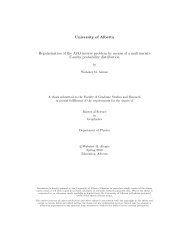Soner Bekleric Title of Thesis: Nonlinear Prediction via Volterra Ser
Soner Bekleric Title of Thesis: Nonlinear Prediction via Volterra Ser
Soner Bekleric Title of Thesis: Nonlinear Prediction via Volterra Ser
Create successful ePaper yourself
Turn your PDF publications into a flip-book with our unique Google optimized e-Paper software.
In applied seismology predictive deconvolution (another form <strong>of</strong> linear predic-<br />
tion) was introduced by Robinson (1954) to solve the source deconvolution problem<br />
when the seismic source function is unknown. Predictive deconvolution is at the<br />
heart <strong>of</strong> seismic exploration seismology and used on a daily basis to enhance the res-<br />
olution <strong>of</strong> seismic records and produce estimates <strong>of</strong> the earth’s reflectivity sequence<br />
from seismic probes (Robinson and Treitel, 1980).<br />
Canales (1984) proposed to use linear prediction methods to predict 2D wave<br />
fields in the f − x domain (frequency-space). The technique proposed by Canales<br />
is the cornerstone <strong>of</strong> methods to increase the signal to noise ratio (SNR) <strong>of</strong> seismic<br />
records. In this case, the signal at a given channel for a monochromatic frequency f<br />
can be predicted <strong>via</strong> a linear combination <strong>of</strong> waveforms measured at adjacent chan-<br />
nels. If a signal can be predicted, the mismatch that exists between the predicted<br />
signal and the observed signal is considered an estimate <strong>of</strong> the noise in the data.<br />
The latter is a summarized description <strong>of</strong> f −x deconvolution for the attenuation <strong>of</strong><br />
spatially random noise. Linear prediction is also the basis <strong>of</strong> algorithms for seismic<br />
record interpolation (Spitz, 1991; Naghizadeh and Sacchi, 2007).<br />
<strong>Nonlinear</strong> prediction, on the other hand, is the prediction <strong>of</strong> a signal from non-<br />
linear combinations <strong>of</strong> its past or future values (Wiener, 1958). <strong>Nonlinear</strong> prediction<br />
arose in the study <strong>of</strong> nonlinear systems for the treatment <strong>of</strong> weak nonlinearities<br />
arising in system theory (Cherry, 1994). In addition, nonlinear prediction has been<br />
used to predict the behavior <strong>of</strong> geophysical signals in the context <strong>of</strong> hydrological<br />
studies (Bracalari and Salusti, 1994), ocean waves interactions with platforms (Koh<br />
and Powers, 1985; Powers et al., 1990).<br />
2









